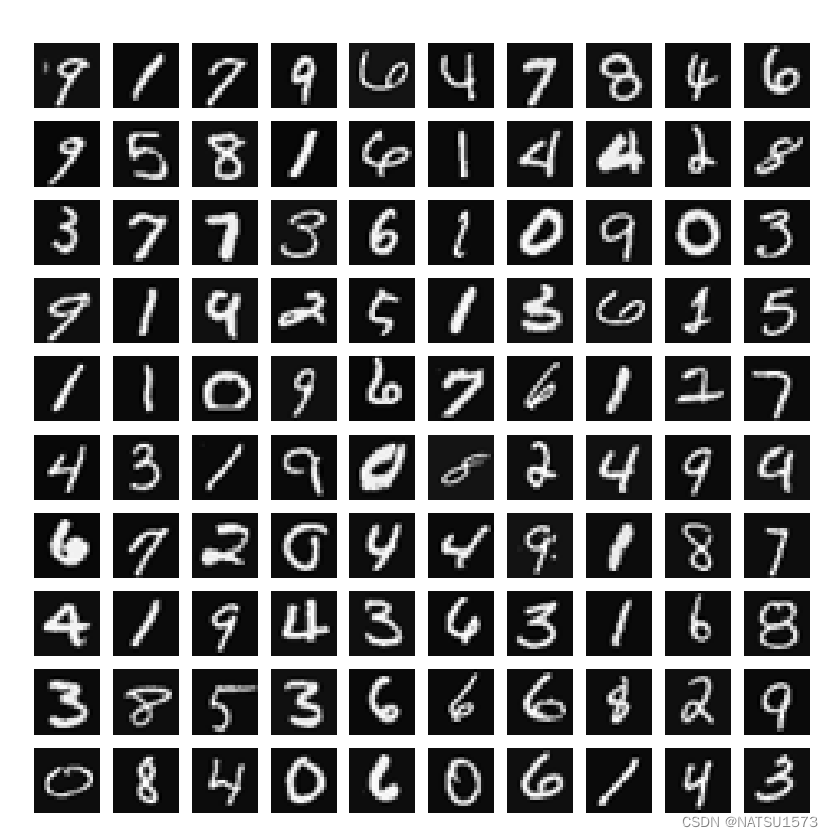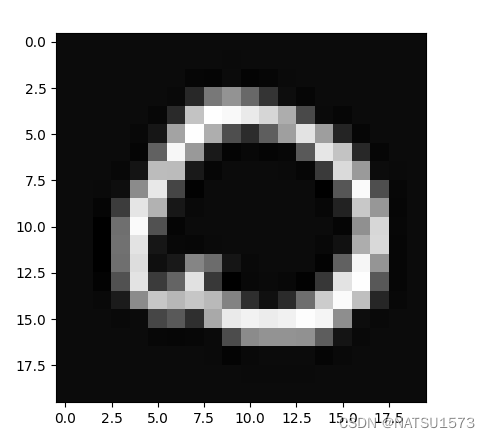吴恩达机器学习之手写数字识别——logistic回归
本部分主要是通过logistic回归解决多分类问题,对每一个维度建立对应的logistic回归方程,对每一个结果值进行预测,最大的概率值即为可能的结果。
数据集介绍
数据集下载地址,在下面的博客链接可以下载:
https://blog.csdn.net/weixin_47598128/article/details/139394307?spm=1001.2014.3001.5501
数据集为0-9的手写数字,下面进行数据加载并进行具体介绍:
import numpy as np
import matplotlib.pyplot as plt
import pandas as pd
from scipy.io import loadmat
import scipy.optimize as opt
# 加载数据
path = "ex3data1.mat"
data = loadmat(path) # 返回一个字典
# print(data.keys())
x = data['X']
y = np.array(data['y'])
print(x.shape, y.shape)
print(np.unique(y))
# output
# (5000, 400) (5000, 1)
# [ 1 2 3 4 5 6 7 8 9 10]
数据类型为mat,这是MATLAB的一种输出数据类型,其中存放的数据按照索引名称,可以理解为存放的为数组。
X:代表5000个手写数字图像,一个图像为一个1400的矩阵,为一个2020矩阵扁平化的结果。
Y:对手写数字图像的预测值,其中1-9的预测值为对应的数组,而0的预测值被映射为10,或许和我们的思维方式有些不同,但是这对模型训练和结果预测并没有影响。
输入数据转化成图像,展示其中的一百个如下:
# 显示部分数据
sample_idx = np.random.choice(np.arange(x.shape[0]), 100, replace=False)
sample_images = x[sample_idx, :]
print(sample_images.shape)
pic_sample(sample_images)
def pic_sample(x):
fig, axs = plt.subplots(10, 10, figsize=(10, 10))
for i,ax in enumerate(axs.flat):
ax.imshow(x[i, :].reshape(20, 20).T, cmap='gray')
ax.axis('off')
plt.show()
input()

模型训练
在了解了输入数据之后,下面需要进行模型创建。
相较于传统的二分类问题,手写数字识别为一个“十分类”问题,也就是类别是10个,我们无法像二分类问题一样,建立一个logistic方程来实现分类;而需要创建10个logistic方程。
损失函数
损失函数的定义和二分类问题一样:
c
o
s
t
=
1
m
∑
i
=
1
m
(
−
y
lg
h
θ
(
x
i
)
−
(
1
−
y
)
lg
1
−
h
θ
(
x
)
)
+
l
r
∗
1
2
m
∑
j
=
1
n
θ
j
2
cost = \frac{1}{m}\sum_{i=1}^{m}(-y\lg{h_\theta(x^i)}-(1-y)\lg{1-h_\theta(x)})+lr*\frac{1}{2m}\sum_{j=1}^{n}\theta_j^2
cost=m1∑i=1m(−ylghθ(xi)−(1−y)lg1−hθ(x))+lr∗2m1∑j=1nθj2
在程序实现中,需要重点考虑输入,输出的维度关系:
def sigmoid(z):
return 1 / (1 + np.exp(-z))
def cost_function(theta, X, y,lr):
hx = sigmoid(np.dot(X,theta))# (n,)
left = -np.dot(y.T, np.log(hx))
right = -np.dot((1-y).T, np.log(1-hx))
reg = lr*np.sum(theta[1:]*theta[1:])
return (left + right) / X.shape[0] + reg / (2*X.shape[0])
梯度计算
对损失函数求导可以得到梯度函数
g
r
a
d
=
1
m
(
∑
i
=
1
m
(
h
θ
i
−
y
)
x
j
+
λ
θ
j
)
grad = \frac{1}{m}(\sum_{i=1}^{m}(h_\theta^i-y)x_j+\lambda\theta_j)
grad=m1(∑i=1m(hθi−y)xj+λθj)
def gradient(theta, X, y,lr):
hx = sigmoid(np.dot(X,theta))# (n,)
error = hx - y.T
reg = lr*theta
grad = np.zeros(theta.shape[0])
grad[0] = np.sum(error * X[:,0]) / len(X)
grad[1:] = (np.dot(error,X[:,1:]) + lr*reg[1:]) / X.shape[0]
return grad
模型训练
在构建了损失函数和梯度函数,即可调用opt模块下的梯度下降算法对模型参数进行求解。
这里需要注意的是,手写数字识别包含10个预测输出,因此模型的参数 θ \theta θ维度应当是10*xxx
数据预处理
x = np.array(x)
x = np.insert(x,0,1,axis=1)
y = np.array(data['y'])
lr = 1
将x,y转化为np.array类型的数据,方便后续处理。
梯度下降
theta_all = grad_all(x,y,lr)
def grad_all(X, y,lr):
theta_all = np.zeros((10,X.shape[1]))
for i in range(1,11):
y1 = np.zeros(y.shape[0])
y1 = [1 if k==i else 0 for k in y]
y1 = np.array(y1)
theta = np.zeros(X.shape[1])
cc = cost_function(theta, X, y1,lr)
res = opt.fmin_tnc(func=cost_function, x0=theta, fprime=gradient, args=(X, y1,lr))
theta_all[i-1,:] = np.array(res[0])
return theta_all
由于数据集中0被映射到了10,所以在梯度下降for循环中从1开始循环到10,其中每个预测结果需要进行一次梯度下降,设定梯度的初始值为0,将每个梯度下降的参数值保存在theta_all中。
print(theta_all.shape)
print(theta_all)
#(10, 401)
[[-2.38281017e+00 0.00000000e+00 0.00000000e+00 ... 1.30443542e-03
-7.53309574e-10 0.00000000e+00]
[-3.18121769e+00 0.00000000e+00 0.00000000e+00 ... 4.45968899e-03
-5.08467340e-04 0.00000000e+00]
[-4.80106714e+00 0.00000000e+00 0.00000000e+00 ... -2.86733237e-05
-2.45166522e-07 0.00000000e+00]
...
[-7.98811053e+00 0.00000000e+00 0.00000000e+00 ... -8.94231716e-05
7.21142495e-06 0.00000000e+00]
[-4.56980369e+00 0.00000000e+00 0.00000000e+00 ... -1.33316062e-03
9.98306587e-05 0.00000000e+00]
[-5.40646673e+00 0.00000000e+00 0.00000000e+00 ... -1.16765402e-04
7.89328055e-06 0.00000000e+00]]
结果预测
使用得到的参数预测输入数据集的结果,并计算正确率:
def predict(theta_all, X):
hx = sigmoid(np.dot(theta_all,X))
num = np.argmax(hx, axis=0)+1
return num
num = predict(theta_all,x.T)
acc = [1 if num[i] == y[i] else 0 for i in range(len(y))]
a = sum(acc)/len(acc)
print(a)
# 0.9446
随机挑选一幅图像
# 预测
t = 100
img = x[t,1:]
plt.figure(1)
plt.imshow(img.reshape(20,20).T,cmap='gray')
plt.show()
num = predict(theta_all,x[t,:])
print(num)
# num=10






















 896
896

 被折叠的 条评论
为什么被折叠?
被折叠的 条评论
为什么被折叠?








